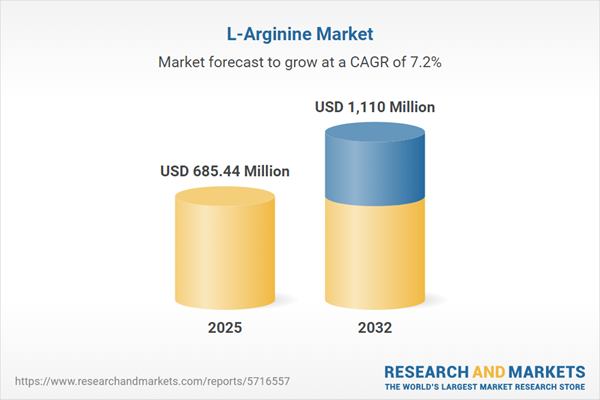Speak directly to the analyst to clarify any post sales queries you may have.
L-Arginine is emerging as a cornerstone in nutritional, therapeutic, and industrial sectors, driven by its multifaceted applications in health, bioprocessing, and manufacturing innovation. Senior leaders navigating this market require data-driven insights and actionable recommendations to shape resilient growth and product strategies in a fast-evolving landscape.
Market Snapshot: Growth and Demand for the L-Arginine Market
The global L-Arginine market advanced from USD 638.32 million in 2024 to USD 685.44 million in 2025 and is projected to reach USD 1.11 billion by 2032, growing at a CAGR of 7.22%. This expansion reflects intensifying interest from the food, pharmaceutical, nutraceutical, and industrial sectors. Market movement is underpinned by rising consumer health awareness, innovation in bioactive delivery, and diversification of end-use cases. Current growth signals sustained investment, increased end-user uptake, and widespread technology adoption across segments.
L-Arginine Market Scope & Segmentation
This report delivers a comprehensive analysis of key L-Arginine market segments, technology trends, and geographical expansion:
- Type: Includes both fermented and synthetic production methods, catering to varied purity and application requirements.
- Form: Covers capsules, liquid, powder, and tablets, serving pharmaceutical, nutritional, and functional food formulations.
- Application: Spans animal feed, cosmetics, dietary supplements, food and beverage, and pharmaceuticals.
- End User: Encompasses animal feed companies, cosmetics manufacturers, food and beverage producers, nutraceutical firms, and pharmaceutical organizations.
- Distribution Channel: Reflects both offline—direct sales, pharmacies and drugstores, specialty stores, supermarkets/hypermarkets—and online channels, including brand websites, direct e-commerce platforms, and third-party marketplaces.
- Region: Market coverage spans the Americas (North and Latin America), Europe, Middle East & Africa, and Asia-Pacific, with further breakdowns for each sub-region and country.
- Leading Companies: Analysis includes major players such as Ajinomoto, Evonik Industries, Kyowa Hakko Bio, CJ CheilJedang, Prinova Group, Cargill, Gnosis, Fagron, Albion Laboratories, and Bioiberica.
L-Arginine Market: Key Takeaways for Senior Decision-Makers
- Expanding applications in nutritional supplements, pharmaceuticals, and animal feed drive sector convergence and increase value-chain integration.
- Advancements in fermentation and chemical synthesis are enhancing both scalability and purity, supporting specialized use and regulatory compliance.
- Innovative delivery systems including microencapsulation and sustained-release matrices are improving ingredient bioavailability and efficacy.
- Regional opportunities emerge from varying regulatory frameworks, with EMEA emphasizing sustainability, Asia-Pacific scaling output, and the Americas focusing on product innovation.
- Collaboration among producers, research institutions, and downstream manufacturers accelerates development of new grades and proprietary formulations.
- The nutritional ingredients sector, as a secondary keyword, is closely linked to growth in functional foods and personalized nutrition.
Tariff Impact on L-Arginine Trade and Supply Chains
Recent United States tariff adjustments have shifted traditional import dynamics and cost structures, leading to renegotiated sourcing agreements, strategic stockpiling, and diversified logistics networks. These changes require both suppliers and buyers to adopt more flexible contracting and forecasting to mitigate volatility and ensure continuity.
Methodology & Data Sources
Insights in this report leverage primary interviews with industry leaders, complemented by secondary analysis of regulatory filings, peer-reviewed publications, and public trade records. Rigorous data triangulation and expert validation underpin the accuracy and relevance of the findings for senior supply chain and R&D stakeholders.
Why This Report Matters
- Supports executive decision-making with segmented market visibility and practical, region-specific recommendations.
- Enables procurement teams to benchmark sourcing, compliance, and innovation strategies against leading competitors and evolving global regulations.
Conclusion
L-Arginine’s expanding relevance is shaping a dynamic global market ecosystem, intersecting health, technology, and regulatory priorities. Leaders implementing integrated, adaptive approaches will be best positioned to capture emerging value in this essential ingredient sector.
Additional Product Information:
- Purchase of this report includes 1 year online access with quarterly updates.
- This report can be updated on request. Please contact our Customer Experience team using the Ask a Question widget on our website.
Table of Contents
3. Executive Summary
4. Market Overview
7. Cumulative Impact of Artificial Intelligence 2025
Companies Mentioned
The companies profiled in this L-Arginine market report include:- Ajinomoto Co., Inc.
- Evonik Industries AG
- Kyowa Hakko Bio Co., Ltd.
- CJ CheilJedang Corporation
- Prinova Group LLC
- Cargill, Incorporated
- Gnosis S.p.A.
- Fagron N.V.
- Albion Laboratories, Inc.
- Bioiberica, S.A.
Table Information
| Report Attribute | Details |
|---|---|
| No. of Pages | 180 |
| Published | November 2025 |
| Forecast Period | 2025 - 2032 |
| Estimated Market Value ( USD | $ 685.44 Million |
| Forecasted Market Value ( USD | $ 1110 Million |
| Compound Annual Growth Rate | 7.2% |
| Regions Covered | Global |
| No. of Companies Mentioned | 11 |









